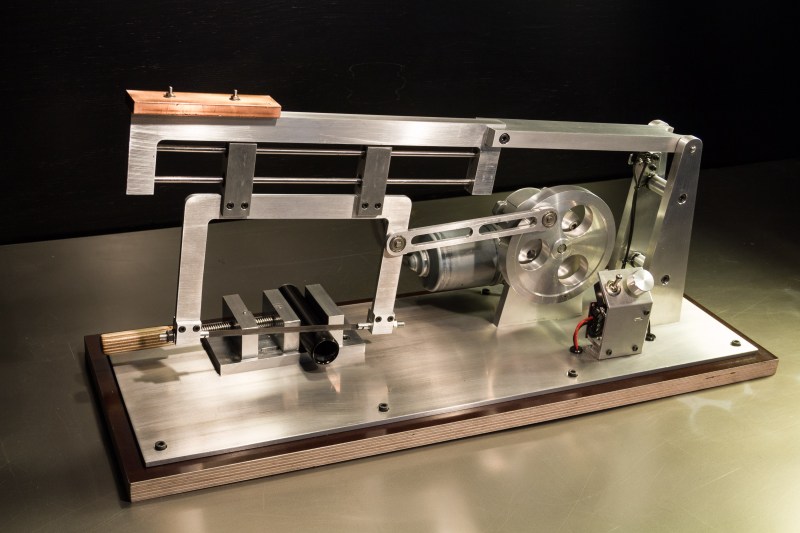[Alex] is no stranger to making machines of negligible utility. A few years ago he made the Almost Useless Machine, a solar-powered system that cuts through a 20mm dowel rod while you wait (and wait, and wait). Enamored by the internet’s bevy of powered hacksaws, he sought to build a sturdier version that’s a little more useful. Approximately five months of free time later, he had the Almost Useful Machine.
It runs on a wiper motor and a recycled power supply from a notebook computer. [Alex] rolled his own board for controlling the motor with an ATtiny25. The circuit turns potentiometer movement into PWM, which controls the motor through a MOSFET. After the cut is finished, an endstop microswitch immediately cuts the motor.
Every bit of the chassis is aluminum that [Alex] machined by hand. Don’t have that kind of setup? How about a powered hacksaw with a 3D-printed linkage? Make the jump to see it in action, and stick around for the two-part time-lapse build video.
















A truly beautiful saw build, one which actually seems quite useful to me.
Larger versions are common in industry.
Sexy versions are popular in the pornography industry.
This is actually pretty useful if you have the time to wait. And beautiful too, very smooth motion and very simple, this is engineer porn right here
It’s even more usefull if you go do something else untill it’s finished.
Indeed, nicely done, but otherwise a small scale copy of a normal metal saw.
http://i982.photobucket.com/albums/ae302/lenne0815/CNC%20v2/DSC_0001-2.jpg
Ok, now I am curious, what is advantage of this linear saw over circular one ?
It seems to me the same saw can cut a large range of diameters, or non-round objects, while a circular saw would need to be a much larger diameter to do that. Or maybe it has to do with running unattended, while a circular saw would need someone to hold or push it down ?
Not needing a circular blade?
Less chance to lose a finger?
Greater chance of grabbing clothing? That’s very poorly guarded.
Advantages are a smaller kerf compared to a circular saw (expensive material is saved). The saw blade can be manufactured for a lower price, because geometry is simpler and needs less material. Perhaps you already have the blade and sharpening tools because they are used in hand saws. The entire machine is simpler, does not wear that much and easy to maintain & repair.
If every penny counts and time is not that important, it is still a good alternative.
+1 all the above.
Plus less heat generated from the cut.
In the maker’s video the end of the cut looks even and could be polished with no distortion. Lapidary applications if an abrasive was added.
Could be useful with harder material if a cutting fluid was used.
No so unuseful.
Lapidary saws (for cutting rocks ikydn) all were like this before diamond blades became common and affordable. The blade would be plain mild steel and there would be another mechanism to release a little grit into the cut with each stroke of the blade. Such saws were used to slab boulders a meter or more in diameter in the field so they could be transported to shops for finer work.
None for a bandsaw, there is a reason no one build these machines anymore.
As for circular saw, it depends on what kind, abrasive saws are messy, noisy, smelly, and are general fire hazards. Cold saws are awesome, they can leave a machined finish accurate to a few thousandths of an inch every time. The cheaper saws like the Evolution saws run faster and produce hotter chips and dont use coolant.
When would I use a power hacksaw over a circular type? Only if I had to use an abrasive saw. The one advantage an abrasive saw has is they can cut hardened materials like linear way rails.
Thank you guys. Your responses are very useful.
Useful for a Sloth
It could become a clock. Automatic saw timed so a fresh cut-off strikes a gong every hour!
Actually that’s a really good, off the wall idea, and why not use rods made of CNC wax, that way you could recycle your rods.
I’ve had a few ideas ever since the levitating aluminum. If I make something good I’ll retire my dumb username and create an ‘io’ account. HaD is giving me too much inspiration! Thanks for the ‘like’. :)
Very nicely done! Would be just slightly more interesting if it also included a bar that automatically turned off the power switch during that last drop after completion.
“After the cut is finished, an endstop microswitch [] immediately cuts the motor.”
is this art?
Anything could be considered ‘art’.
There was a lot of milling involved, and it looks stylish to me.
This machine has more personality than most people I’ve met.
Got 20s into the build video. Reaches into the milling envelope while wearing gloves. So many nope.